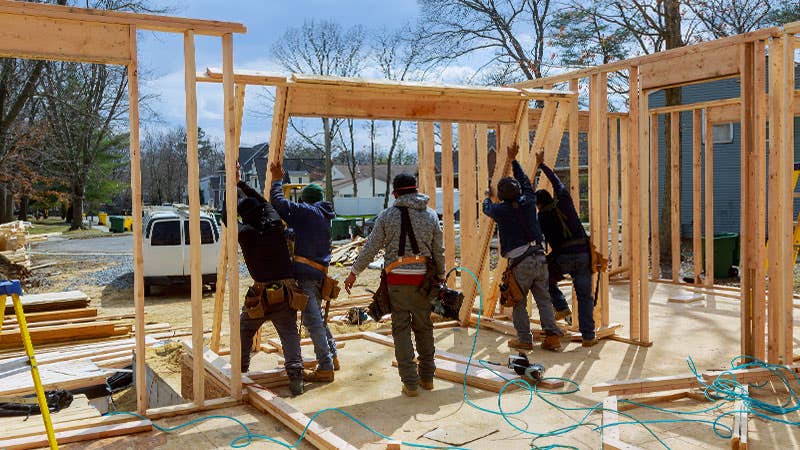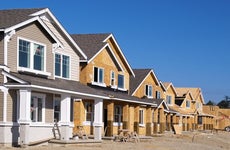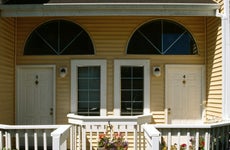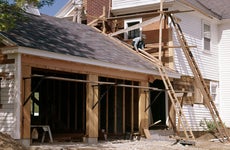How much does it cost to build a house?

The Bankrate promise
At Bankrate we strive to help you make smarter financial decisions. While we adhere to strict , this post may contain references to products from our partners. Here's an explanation for .
If you’re looking for a house but haven’t found the perfect one, you might be wondering what it would take to build a brand-new home of your own. Building a house might be less expensive than you think, and there are several financing options available to help. However, construction costs soared at the height of the pandemic due to supply chain disruptions and labor shortages, so prices — and time frames — are up.
How much does it cost to build a brand-new house?
The average cost to build a single-family home in 2022 was $284,764, according to data from HomeAdvisor. That price, however, can range from as low as $110,765 to as high as $459,152. Prices vary widely depending on the region of the country where you’re building and the specific details of your home plans.
Cost of new construction per square foot, by region
Here are average construction costs around the country, according to HomeGuide.
- Northeast: $155 per square foot
- West: $131 per square foot
- Midwest: $109 per square foot
- South: $100 per square foot
So, if you’re looking to build a 2,000-square-foot home in the South, you can expect it to run around $200,000. Note that these figures take into consideration only the cost of construction — they do not include the price of the land to build on.
Home building costs, broken down
You’ll need to take into account a number of key points to estimate the true cost of building a new home. Here’s a breakdown of some of the costs that might factor into your construction budget. All prices are based on construction of a 2,000-square-foot home.
| Construction phase | Average cost |
|---|---|
| Sources: HomeGuide and HomeAdvisor | |
| Excavation | $3,000 |
| Foundation, slab and piers | $9,260 |
| Roofing | $13,760 |
| Rough lumber | $16,000 |
| Rough carpentry labor | $22,260 |
| Heating and ducting | $7,260 |
| Plumbing and sewer connections | $18,260 |
| Gypsum wallboard | $11,760 |
| Drive and walkway | $6,000 |
| Wiring | $8,000 |
| Painting | $9,000 |
| Flooring | $5,000 |
| Land | $3,000 – $150,000 |
Pre-construction
You’ll need to secure the appropriate permits and pay fees to your city or municipality before the work on your home can begin. You’ll also need to hire architects and engineers to make plans for your home. These costs all vary by location but you can expect to spend about $4,220 on permits and about $1,000 to $2,000 on plans and specifications.
Foundation
The foundation of your new home is a major part of the process and can be a significant part of the overall cost. Excavation costs around $3,000, and foundation work runs about $9,260.
Exterior
You’ll have to complete the exterior of your home with a roof, siding, windows and doors once the frame of your house is in place. The cost for each of these items may vary based on the materials you choose. However, roofing averages about $13,760, while windows and sliding doors may be about $3,000, and expect to tack on another $4,760 for standard doors throughout the home. A stucco exterior averages about $16,000; siding costs can vary widely depending on square footage and material type.
Home systems
The infrastructure that heats your house and provides water and electricity is essential. Expect to spend more than $7,000 on heating and ductwork, in excess of $18,000 on plumbing and sewer requirements and about $8,000 on electrical wiring.
Interior
From insulation to walls, cabinets and flooring, finishing the interior of your home is one of the most expensive parts of the project. The cost of gypsum wallboard for a new-build home is nearly $12,000. Cabinets, which range in style from basic to luxurious, vary widely in price but you could spend $9,000 or more. Similarly, flooring costs range significantly depending on materials but typically run at least $5,000.
Outdoor
Most suburban homes have a driveway and walkway to the front door, and they may also include a deck or patio and some form of landscaping. These features can add up quickly. The cost of just a driveway and sidewalk is about $6,000. Installation of front- and backyard landscaping averages an additional $3,451, according to HomeAdvisor.
Labor
Labor is one of the most important costs involved in home construction — and also one of the most difficult to measure. The final price tag will vary significantly based on each new home’s plans and the amount of work involved. Labor often makes up about 30 to 50 percent of a home’s total construction cost, per HomeAdvisor.
Expect to pay for a long list of subcontractors and specialized experts to help complete your home project, including roofers, electricians, plumbers, flooring specialists and more. The cost of labor increased during the pandemic, thanks to greater numbers of homeowners taking on remodeling projects, and may still be inflated. “You may also face long wait times for high-quality tradespeople due to high demand,” says Mischa Fisher, chief economist for Angi.
Land
Of course, before embarking on your new home’s construction, you will need a place to put it. The land costs associated with new home construction typically include the purchase price for the property and also land preparation, such as tree removal or leveling.
Like many other factors associated with the construction of a new home, the cost of land can range widely. According to HomeAdvisor, these costs vary significantly depending on the size of the lot, its location and whether or not it is already connected to utility services. Based on these factors, you may spend anywhere from $3,000 to $150,000 on acquiring land.
Is building a home cheaper than buying?
It’s the opposite, in fact: In general, building a new home tends to cost more than buying an existing one. According to a 2022 report from HomeAdvisor, builders can expect to spend about 5 percent to 10 percent more per square foot than buyers.
Buying a pre-existing house and simply renovating it to meet your needs can provide more value per square foot — just how much you will save, however, depends on its condition and many other factors. “While it depends on the location and size of the home, buying an existing home and remodeling is probably cheaper than building in many areas,” says Fischer.
“If you’re willing to live in a home that doesn’t necessarily have this year’s remodeling upgrades, there’s a lot of money to save by buying a house rather than building one,” says Thomas Jepsen, founder of Passion Plans, a website that helps consumers build their dream homes.
It’s important to think about your priorities, too, says David Logan, senior economist and director of tax and trade policy analysis at the National Association of Home Builders. New homes tend to be bigger and more customized, but are also often farther from city centers and public transportation because land in exurbia is cheaper and easier to acquire.
Home building financing options
If you’ve determined that the price of construction is worth it, your next step is to explore your financing options for a new-home build. There are several options available, and many offer competitive interest rates and attractive incentives.
Home construction loan
By far the most common form of financing to build a house, home construction loans are designed exactly for this purpose. There are two main types:
- Construction-to-permanent: A construction-to-permanent loan is a single loan that covers the costs of both land and construction, eventually converting to function in the same way as a mortgage.
- Construction-only: Also known as standalone construction loans, these finance only the construction of your new home. That requires you to take out two separate loans, this one plus a mortgage, which can lead to higher fees and interest rates. This type might make more sense if you currently own a home and plan to sell it and use the proceeds to pay off the loan on your newly constructed home.
Personal loan
You probably won’t come close to financing the entire cost of building a house with a personal loan — the loan amount will be capped for most people at much less than the cost of a house. But you may use this method to pay for specific projects.
For example, if you’ve already secured a certain amount of financing for the construction of your home but need additional financing for landscaping, a personal loan could do the trick. Just keep an eye on your finances and make sure you’re not overcommitting.
Home equity loan
If you already own a home and want to build a new one, you might consider using a home equity loan on your first house to finance all or part of the second. The amount you can borrow will depend on how much equity you have in your current home. If you own it outright, you might be able to finance the majority of your new home.
Once construction is complete and you move into your new home, you can use the money from the sale of the first house to pay off the home equity loan.
Home equity line of credit
A home equity line of credit (HELOC) is another good option for financing the cost of building a house, provided you have a significant amount of equity. Like a home equity loan, you’ll borrow against the equity in your current house to procure financing to help build a new one. The difference is that a HELOC acts more like a credit card than a lump-sum loan, and you’ll be able to borrow from the line of credit as needed, up to the amount that you’re approved for.
You’ll also have more flexibility and can choose how much you actually borrow from a HELOC, and you can pay it back and borrow again as needed. This is highly advantageous when constructing a new home, since costs often fluctuate and additional unforeseen expenses can arise at any moment.
Tips to save on building a house
The best way to save on building a house is to get multiple quotes for every step of the process. Talk to several real estate agents, architects, builders and designers and ask each for a written estimate. If one quote is significantly cheaper than the rest, find out why before signing on the dotted line. You don’t necessarily want to pick the least expensive option; it could leave you with a poorly built house that requires frequent emergency repairs or costly add-ons that weren’t included in the initial quote.
You can also save money by doing some of the work yourself. For example, instead of hiring an interior designer, choose the interior finishes yourself. Just be prepared for a significant time investment if you decide to take this route, as you’ll be responsible for choosing everything from flooring to paint to countertops.
FAQs
-
It’s typically cheaper to buy an existing home and remodel it to your taste than it is to build a new home from scratch. The savings can be between 5 percent to 10 percent per square foot, per a 2022 report from HomeAdvisor.
-
So-called tiny homes, which are usually less than 600 square feet, are among the cheapest types of homes you can build. The construction costs range from $30,000 to $60,000 but averages about $45,000, according to HomeAdvisor.
-
Home construction loans are the most common way to finance the building of a new home. You might also be able to finance at least part of the expense with a personal loan, home equity loan or home equity line of credit.
Related Articles



